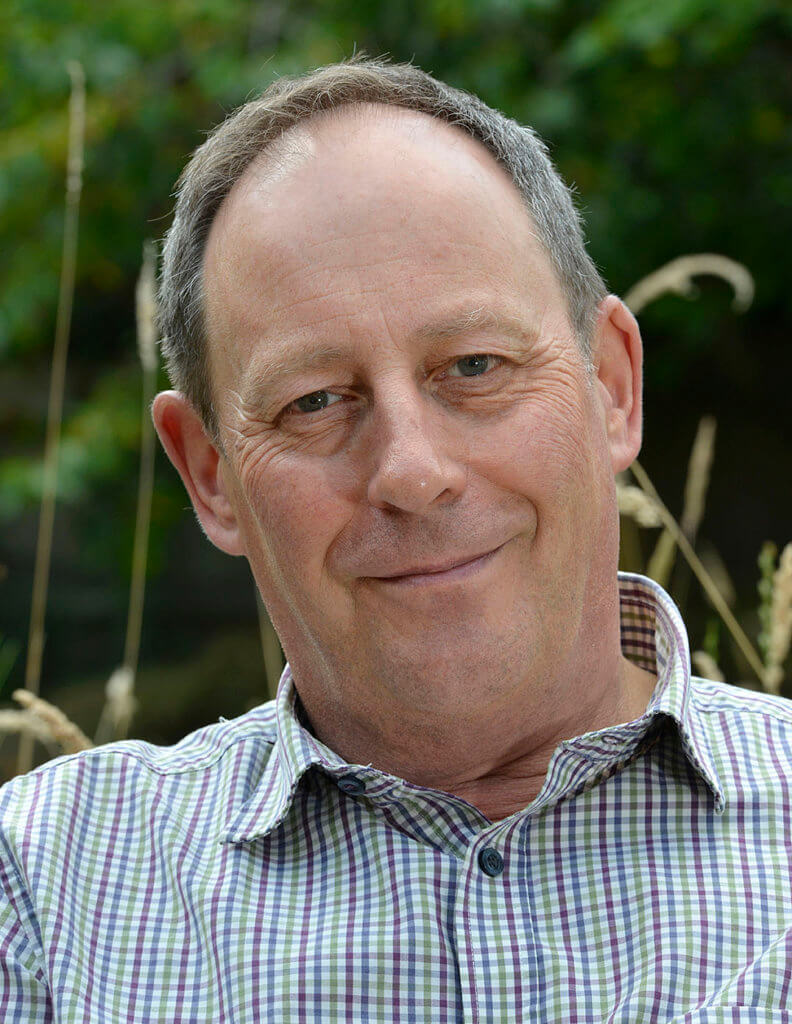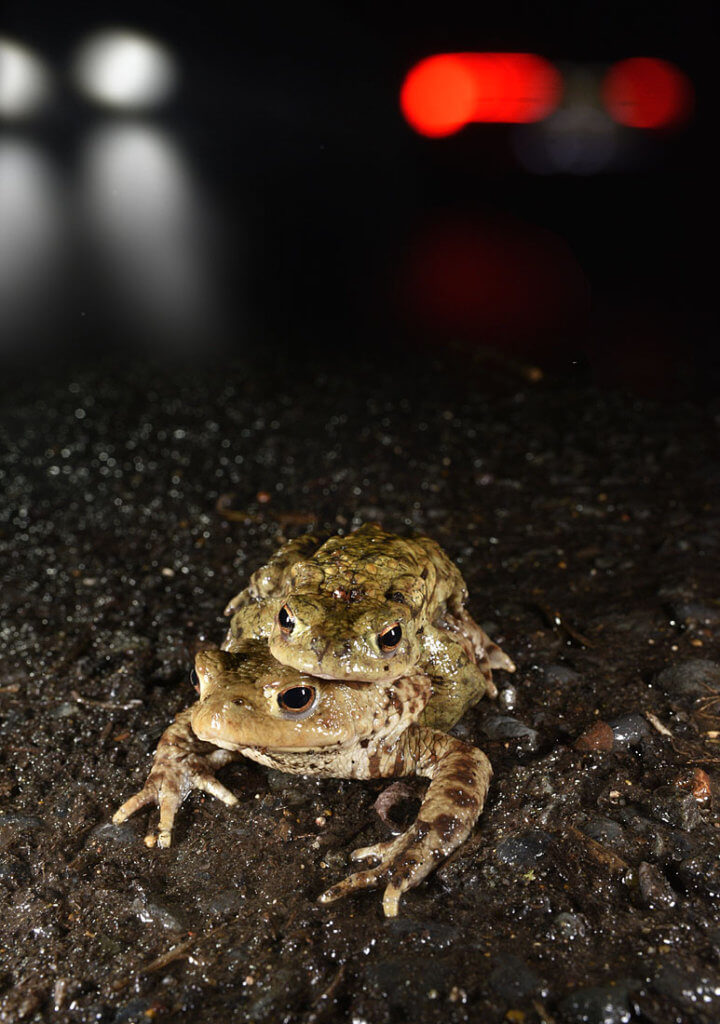
This blog by Dr Paul Sterry follows two earlier ones; Toad Rage and Toad Rage 2.
Paul Sterry has an academic background in freshwater biology and is a passionate conservationist. He has been writing about natural history and photographing wildlife for the last 40 years, with an emphasis on the British scene.
One way or another it’s been an eventful week on the Cufaude Lane Toad front. Just one mouthful of abuse from a passing motorist in the last seven days: that’s a record. And a stern lecture from a van-driver about the foolishness (not quite his words) of pedestrians (even hi-vizzed, torch-bearing ones) walking on country lanes after dark. On a conservation-orientated note there has been an increase in numbers of volunteers this week, the result being a dramatic decrease in the numbers of amphibians being killed compared to those rescued. Surely that must send a clear nationwide message that extra volunteer numbers – even a handful – at Toad Crossing sites throughout the UK truly make a difference.
On her own initiative, one of the volunteers (a considerate lady called Janet) contacted a local business park, asking drivers to slow down and ‘be aware’ of helpers on the toad ‘killing zone’ stretch of Cufaude Lane. That has made a real difference and demonstrates that social media, and communication generally, can be powerful tools in the fight for conservation. Figures for the past week are: Common Toads 254 saved, 37 dead; Common Frogs 19 saved, 7 dead; Smooth Newts 57 saved, 16 dead.
One of the volunteers has been posting information about Cufaude Lane’s Toads to local groups online. Interestingly, on the devices I have looked at Facebook has chosen to overlay one image with an ‘opt-out’ blur displaying the following message: ‘This photo may contain violent or graphic content’. https://www.facebook.com/photo.php?fbid=10156208381843716&set=pcb.1926687040792960&type=3&theater It certainly does but that’s what the Toad Patrollers see every night. Here’s an uncensored version:

Unlucky in love: a squashed pair of Common Toads in amplexus. Photo: Rob Read-www.naturephotographers.co.uk
To get some idea of what Cufaude Lane’s Toad Patrol is like watch this short video created by Rob Read-www.naturephotographers.co.uk
In a previous blog I mentioned that Cufaude Lane’s amphibians are under further attack from a proposed development on adjacent land. In a letter of objection to Basingstoke & Deane Borough Council regarding Planning Application 19/00018/OUT I raised concerns about the standard and scope of environmental survey work undertaken on behalf of developers Croudace Homes; I had specific concerns about amphibians. And on behalf of Cufaude Lane’s amphibians, Andrew Cleave made a powerful representation to a B&DBC cabinet meeting on Tuesday night.
Writing my letter of objection prompted me to re-read the reports from the developer’s environmental consultants Ecosulis, specifically one relating to Great Crested Newts. As the Ecosulis report discloses, they discovered Great Crested Newts (GCN) during survey work undertaken for their paymasters; for what it’s worth, poor things, GCNs are a protected species. In the report Ecosulis dismissed one particular waterbody’s suitability for GCN (Pond 7 in the report) in the following words: ‘Pond 7 returned a HSI (Habitat Suitability Index) score of 0.28, giving it an overall score of Poor. Due to the large size of the pond and the presence of fish it is unlikely great crested newts will utilise the pond. In addition, connectivity between the pond and the site is limited due to the presence of arable field.’ Maybe I missed something but their ‘survey’ appears to be based on hearsay and a glance at Google maps. Fortunately I have visited the site, in the company of the landowner. I would call it a lake rather than a pond and, while I can’t speak for Great Crested Newts, what I saw was a true environmental gem, not some carp-infested mire. The ‘arable land’ referred to is the terrain that Cufaude Lane’s amphibians cross annually to reach water for spawning, not some impenetrable barrier. From a toad’s perspective, this is part of everyday life rather than a ‘limitation’ and the same is true for the area’s other amphibians.
Commonsense and experience tells the Toad Team that Cufaude Lane’s toads and other amphibians are heading towards this particular lake (Ecosulis’ Pond 7) for spawning. With regards to toads in particular, the definitive work on such matters – Collins New Naturalist 87, Amphibians and Reptiles, by Trevor Beebee and Richard Griffiths – makes interesting reading, particularly with regards to Ecosulis’ reference to ‘the presence of fish’. Who knows what the drought and high temperatures of the 2018 summer did for the introduced trout, which were not evident when I visited. But the implications for Common Toads are clear. According to these highly respected authors, Common Toads actually seek out waterbodies where fish are present; the unpalatable taste of their tadpoles gives them a selective advantage over other amphibians.
Croudace Homes are also responsible for development on land immediately adjacent to the current application, a site called Razors Farm. If their commitment to wildlife during the building phase there is anything to go by, I would be worried if I was a newt or a toad. Take a look at the tattered remains of their Reptile and Amphibian Fencing if you are passing that way. Sadly, similar sights of mitigation-associated littering are an all-too familiar sight in southern England today.

The remains of reptile and amphibian fencing at Croudace Home’s Razors Farm development. Photo: Andrew Cleave-www.naturephotographers.co.uk
Understandably I was intrigued to see what Natural England had to say about Planning Application 19/00018/OUT – they had submitted a document which is available on the Planning Portal. What I read had an upbeat and development-friendly feel to it, perhaps with a faint whiff of cut-and-paste. It contained such stringent advice for the developers as ‘You could also consider how the proposed development can contribute to the wider environment and help implement elements of any Landscape, Green Infrastructure or Biodiversity Strategy in place in your area.’ It also included the disclaimer line: ‘Protected Species and Biodiversity – Please note we have not assessed the application and associated documents for impacts on protected species.’ For me, that’s Natural England in a nutshell.
The scales began to fall from my eyes regarding Natural England back in the 1980s when Andrew Cleave and The Woodland Trust fought a battle to save ancient woodland near me, at Bramley Frith (a stone’s throw from Cufaude Lane). A High Court injunction was granted against the woodland’s owners National Grid but then overturned on appeal, on the grounds of ‘over-riding public interest’ or some such phrase. Where was Natural England in all this? A natural ally of conservation you might think. No, they were co-respondents in the court case, alongside National Grid.

Lucky in love: a pair of Common Toads in amplexus that successfully crossed Cufaude Lane, thanks to the help of volunteers. Photo: Paul Sterry – www.naturephotographers.co.uk
I come from a generation that remembers the good old days of nature conservation when Derek Ratcliffe (of ‘Flow Country’ campaign fame) was chief scientist of the Nature Conservancy Council. Were he still alive, I wonder what he would make of that body’s dismembered incarnation, Natural England? Who can say, but what I can say is that Tony Juniper, their new Chair, has got his work cut out if my jaded view of statutory nature conservation is ever going to be assuaged. At the moment it’s as squashed as one of Cufaude Lane’s toads.
[registration_form]
How *dare* people move along a road, as Bill Bryson said, “without benefit of metal”. And if they are killed or injured by a vehicle, it’s obviously their fault, not the drivers’. How awful of them to slow down poor, wonderful drivers, doing their marvelous work of filling the air with the toxins that kill 20,000 people a year in the UK. (Irony.)
And well done to you all for your work in protecting these increasingly rare creatures.
An excellent, ifsomeehst disheartening post. Many readers here will be of the same mind although not all would be able to express their feelings so clearly.
Such local efforts by individuals should make those in charge of protecting our natural environment should cringe the next time they offer cut and paste spurious advice.
You have my sympathies Paul,both for the aggression shown by drivers when doing amphibian patrols ( you can feel there joy as they speed up in an attempt to splash you more effectively ) and for the unbelievably crass and ill-informed reports done by the ecological consultants employed by developers. My feeling is that they should be held to account more as professionals who at best do a very poor job and at worst deliberately try to influence planning procedures by falsehoods.
I was involved with a planning application to try to save a wildlife- rich meadow from being turned into an assault course for an children’s outdoor pursuits centre ( a poor message to give to children I think ). The ecological consultants claimed it was a field of Rye grass. (Google maps ). We fought and managed to save the meadow,however the Activities Centre was given overall permission to turn a wildlife rich habitat into a children’s playground.!As for N.E,don’t get me started.
Wouldn’t it be easier to rent a couple of those of those road sweeping things with the brushes and the vacuum, just go up and down sweeping the toads up with that and then decant them from the tank into the nearest pond when you are finished? Surely it would be less manpower heavy, and more efficient than picking them up one by one?